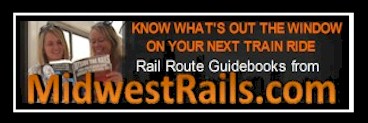1971-1995
Written by the MIdwest Rail Rangers
E-mail: info@railrangers.org
This article is (c)2019 Midwest Rail Rangers Corporation. Note: Amtrak, Pacific Parlour Car, and Coast Starlight are all trademarks of the National Railroad Passenger Corporation. This website is operated for information purposes only and has no affiliation with Amtrak, The Coast Starlight, Budd Company, or any other organization besides the Midwest Rail Rangers.
Amtrak took over operations of most intercity passenger railroad service in the United States starting on May 1, 1971, including that of the Santa Fe. In fact, the Santa Fe was the largest single contributor to Amtrak's original passenger heritage fleet, selling off 447 cars total - including the six Hi-Level lounges. In its early days under Amtrak, the still-combined Super Chief-El Capitan continued to use former Santa Fe passenger equipment almost exclusively. Amtrak even initially retained the Kachina Coffee Shop, Top of the Cap Lounge, Turquoise Room and the Hi-Level Penthouse Diner.
About the only physical changes made to the Hi-Level lounge cars shortly after their transition to Amtrak, were the re-numbering of the cars to Amtrak Lounge Cars #9970, #9971, #9972, #9973, #9974, and #9975... plus the Santa Fe name being covered up, and Amtrak's red and blue stripes added between the side windows.
As time went on though, Amtrak slowly began dismantling many Santa Fe traditions such as on-board nurses, stationary, post cards, meal coupons, rental car arrangements, plus how fares were calculated and baggage was being handled. This caused the Santa Fe's upper management to become increasingly upset. Santa Fe President John S. Reed sometimes inspected Amtrak trains in Chicago and often did not like what he saw. In fact, he was quoted as saying Amtrak's new purple and blue interiors were so bad they resembled "a French whorehouse". Even though the Santa Fe bailed out of the passenger train business, Amtrak was still operating on their right-of-way and a certain level of quality was still expected... as the Santa Fe had 100 years of history in its passenger service.
For its part, Amtrak leadership really resented the meddling of Santa Fe managers, feeling the now-freight only railroad should let them manage passenger operations the way they wanted to. Many at Amtrak felt they were tasked with creating a new homogenized national system versus preserving historic traditions from each of the predecessor railroads.
Tensions between the two went from bad to worse when Amtrak removed the historic Santa Fe El Capitan name from its timetables in April 1973. The final straw was when Amtrak proposed removing the First Class diner and Pleasure Dome from the Super Chief in early 1974. This caused Reed to order Amtrak to cease using the Santa Fe's copyrighted "Chief" names, with the Super Chief becoming the Southwest Limited in May 1974. The Hi-Level lounges would continue to run on this train.
Let's take a look at some more photos from the 1970's of the Hi-Level lounge cars under the now-Amtrak era:
With the Hi-Level equipment reaching over two decades of continual heavy service (and many other single-level railcars that were much older), Amtrak management realized they needed new passenger equipment built for its western long-distance trains. The functionality, durability, and the reliability of the former Santa Fe Hi-Level equipment served as the inspiration for Amtrak's new fleet of Superliner I equipment, which began operating on certain routes as early as February 1979 (much of which is currently still in use today on Amtrak's long-distance lines not operating out of New York).
In October 1980, Amtrak had enough new Superliners cars to assign them to the Southwest Limited between Chicago and Los Angeles. This allowed the somewhat tired Hi-Level equipment to be pulled out of service for a period of time to go through a mechanical and cosmetic refurbishment. According to service records, all six of the Hi-Level lounges were taken to the Santa Fe's shops in Topeka, Kansas for their overhauls at various periods in 1981. Amtrak actually chose the Santa Fe shops to do the work, rather than their own shops at Beech Grove, Indiana. This is where the car was converted to head-end power (from steam heat) and had its original diesel generators removed. An interior refresh also took place, with a step added to each end of the car along with new diaphragm, to make it more compatible to those of the new Superliners (this would allow for mixed trains of both Superliners and Hi-Level equipment if Amtrak so chose).
After this work was completed, the cars were given Amtrak's 'Phase III' exterior paint (with equal red, white, and blue stripes)... and re-numbered to Amtrak Lounge Cars #39970, #39971, #39972, #39973, #39974, and #39975 to indicate they had gone through head-end power conversion.
Following the 1981 re-builds, Amtrak decided not to return the Hi-Level lounges to their original Chicago to Los Angeles (via Albuquerque) routing. This was due to the Southwest Limited being re-equipped with brand new Pullman-Standard built Superliner I Sightseer lounge cars. The Sightseers were considered more modern (including an electric piano downstairs!) and passengers loved the larger windows for viewing scenery over Raton Pass and through the Rocky Mountains of Colorado and New Mexico.
However, there were not enough Superliner lounges manufactured to re-equip all of Amtrak's western long-distance trains. The Hi-Level lounges (and a number of the Hi-Level coaches and Hi-Level dining cars) were re-assigned to traditionally less-scenic routes, such as the Texas Eagle... which operates from Chicago to San Antonio (and onto Los Angeles as part of the Sunset Limited). Amtrak branded its service on the six Hi-Level lounges as a "See-Level Lounge Car", operating as a combined diner-lounge. The cars continued to be used on the Texas Eagle and Sunset Limited routes through the late 1980's and into the early 1990's.
In 1991, Amtrak ordered 140 new Superliner II cars from Bombardier Transportation to supplement its western long-distance fleet, including 15 additional Sightseer lounges. As these cars began to be delivered and put into service between 1993 and 1995, they replaced the Hi-Level See-Level lounge cars on the Texas Eagle and Sunset Limited.
An often-forgot fact is See-Level Lounge Car #39973 (which would later go on to become Pacific Parlour Car "Santa Lucia Highlands") was on the Sunset Limited in 1993 during the Big Bayou Canot wreck. Many people lost their lives in this tragedy, but the ex-Santa Fe Hi-Level lounge survived with little damage because it was towards the back of the consist, and was one of few cars that stayed on the bridge. A photo of the accident (#39973 is highlighted in the pink circle) is posted below; several engines and Superliner coach cars were sent into the bayou. The lounge stayed upright on the bridge. This could have easily been the end for #39973.
By late 1994, the future of the Hi-Level lounge cars looked quick grim. The decision was made to "retire" the ex-Santa Fe heritage Hi-Level cars; they were sent over to Amtrak's shops at Beech Grove, Indiana (outside of Indianapolis), awaiting a decision by Amtrak to either sell them off to a private railroad car group/owner, or possible sell them for scrap.
The story about the Hi-Level cars continues when you click "Amtrak PPC Years" link on the left side. Learn about their amazing transition into what was known for 23 years as the Pacific Parlour Car.
PacificParlourCar.com was founded by Anton Lazzaro and is currently maintained by the Midwest Rail Rangers. If you enjoyed the content, please consider making a donation to our 501(c)(3) non-profit organization. Click the link below; even the smallest amounts help our research, web design, and domain hosting. You can also get in touch with us by e-mailing our Board of Directors: board@railrangers.org.

This rare photo of a Hi-Level lounge car on the combined Super Chief - El Capitan shows it still in its all-silver Santa Fe markings, while the rest of the train's equipment has been repainted in Amtrak's red, white, and blue colors.
The first Amtrak paint scheme for the former Santa Fe Hi-Level lounges included adding red, white, and blue stripes between the windows... covering up the Santa Fe sign with a blank metal plate and red Amtrak sign... and covering up their original Santa Fe car number with a blue sign.
The first Amtrak paint scheme for the former Santa Fe Hi-Level lounges included adding red, white, and blue stripes between the windows... covering up the Santa Fe sign with a blank metal plate and red Amtrak sign... and covering up their original Santa Fe car number with a blue sign.
The first Amtrak paint scheme for the former Santa Fe Hi-Level lounges included adding red, white, and blue stripes between the windows... covering up the Santa Fe sign with a blank metal plate and red Amtrak sign... and covering up their original Santa Fe car number with a blue sign.
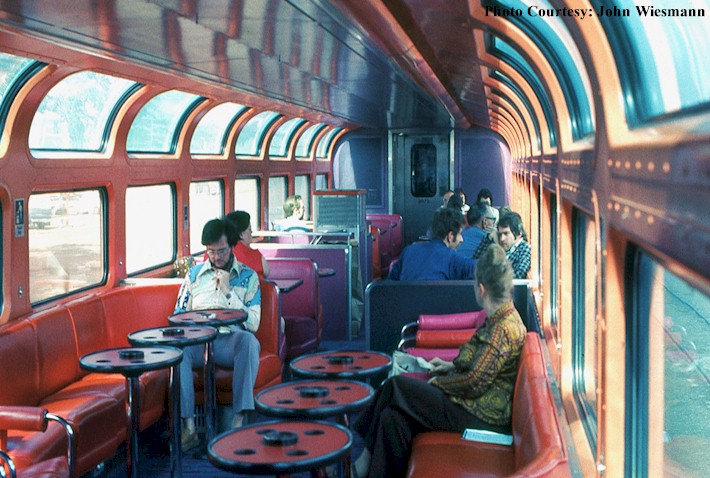
This was what the first re-model of the interior of the Hi-Level lounge cars looked like after Amtrak took over -- as seen on the Southwest Limited train in 1977. The configuration of the car did not change too much, however colors were updated (orange and purple) and different tables were put in that had ash trays and could hold four cocktail drinks each. (Photo Courtesy: John Wiesmann)
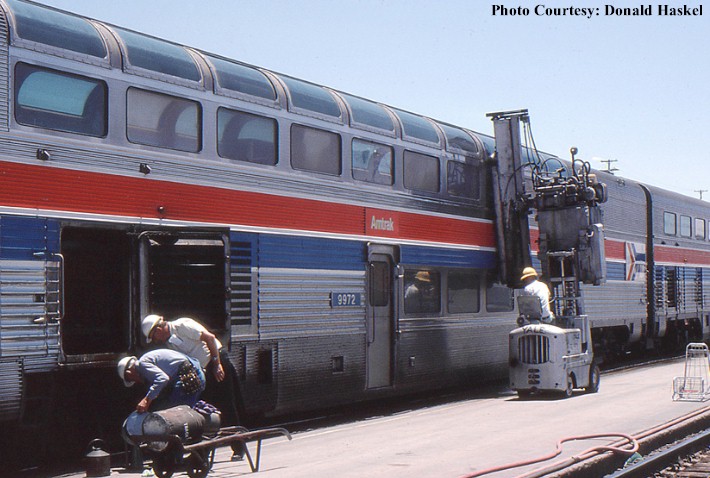
One of the Santa Fe traditions that Amtrak did keep for many years was washing the train windows during the extended stop at Albuquerque, New Mexico, as seen in the above photo. Note the stripe between the windows has been removed, with a more prominent red, white, and blue stripe added to the Hi-Level lounges. This would better match the consist of the other cars in Amtrak's new fleet.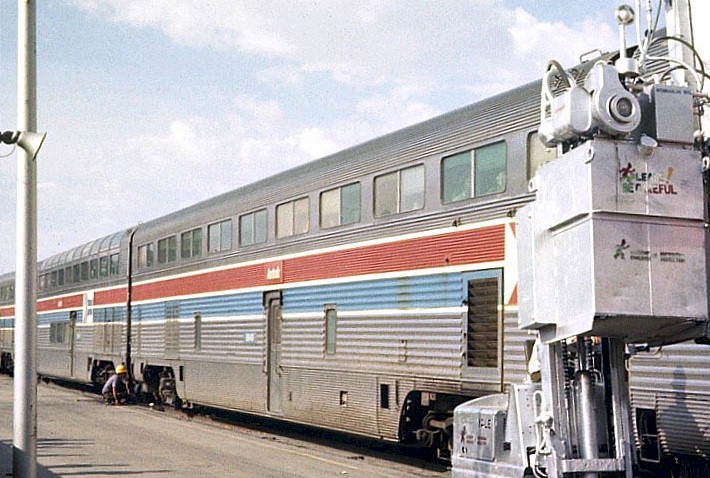
Another view of the Southwest Limited at Albuquerque. A Hi-Level coach is seen in this photo just ahead of the Hi-Level lounge car.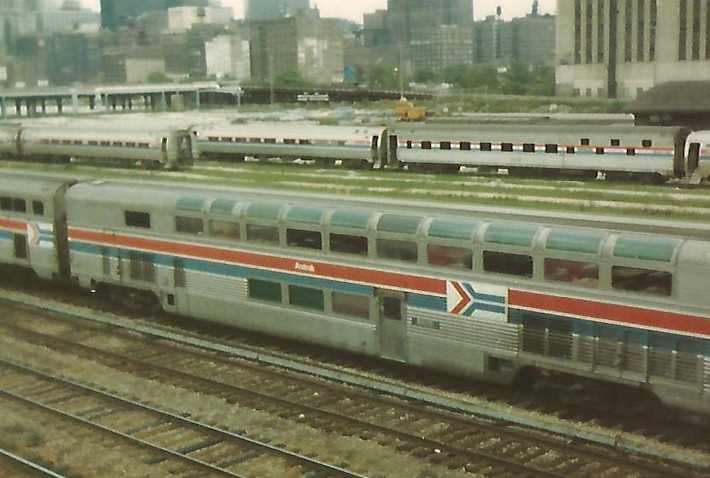
Another view of the original paint scheme for the Hi-Level lounge cars after being taken over by Amtrak.
Get your model! This model railroad advertisement features the Hi-Level lounge car in its original Amtrak paint scheme.
This is the third Amtrak exterior paint scheme designed for the ex-Santa Fe Hi-Level lounge cars. Commonly referred to as the "Phase III" paint scheme, it features equal stripes of red, white, and blue (compared to the previous paint scheme which featured the red and blue more predominantly).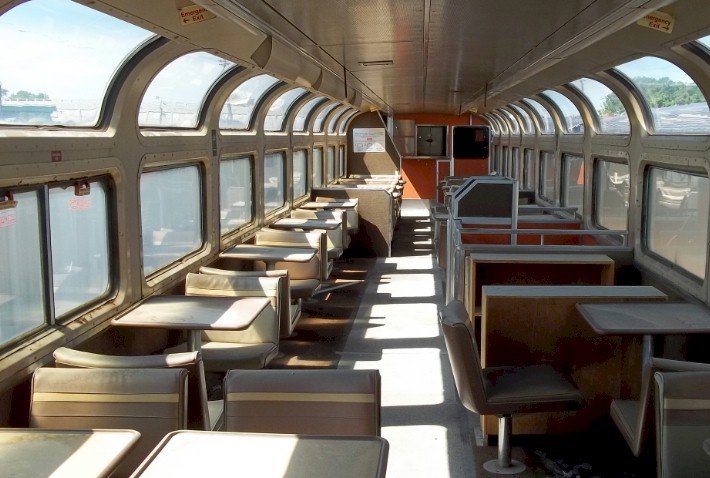
This was the second interior change that Amtrak did to the ex-Santa Fe Hi-Level lounge cars -- accomplished sometime in the late 1980's. The "love seat" couches which were part of the car during the original Santa Fe design and the first Amtrak refurbishments were now replaced with tables and single chairs throughout most of the car. These type of seats and tables are still featured in Amtrak's last remaining dome car "Ocean View".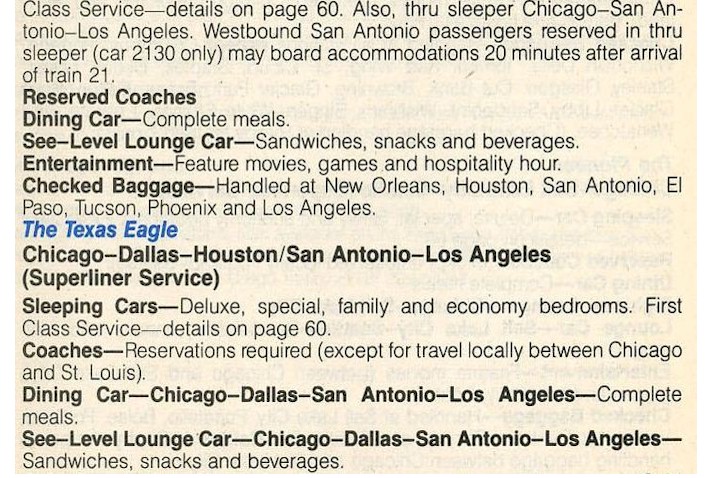
A description in a 1989 Amtrak timetable shows the Santa Fe Hi-level lounges being called "See-Level Lounges" now
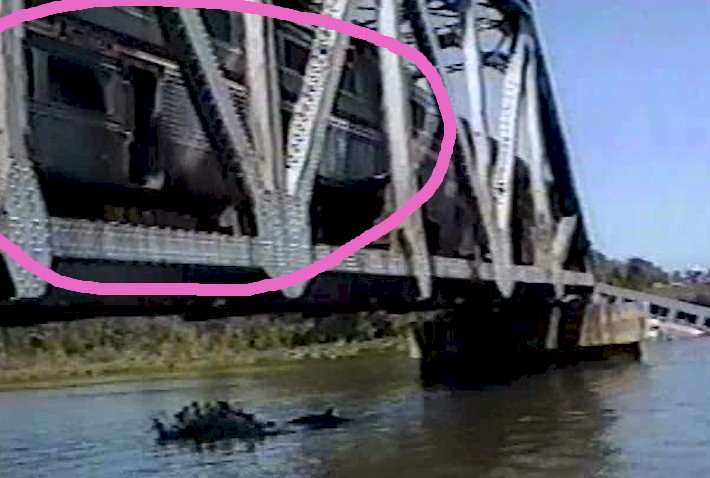
A video still from the scene of the Big Bayou Canot accident shows that #39973 (circled in pink) was just behind another car that partially went off the bridge.
An aerial view of the Bayou Canot train accident; note the See-Level Lounge remained on the bridge and is not seen here.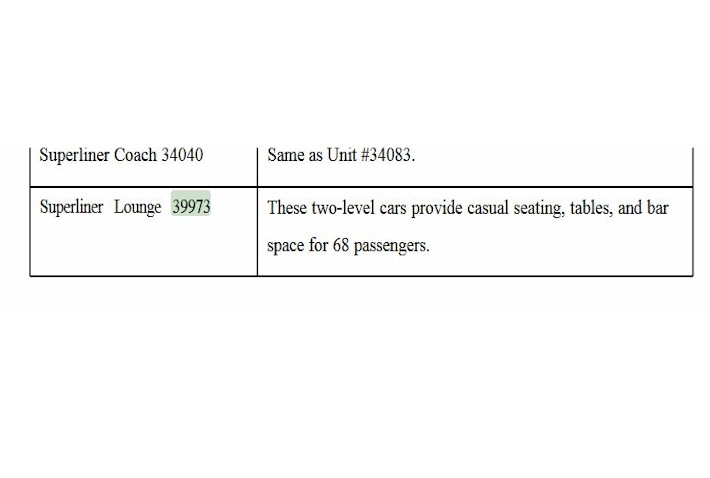
A government report incorrectly identified Car #39973 as a Superliner Lounge Car, however it was not.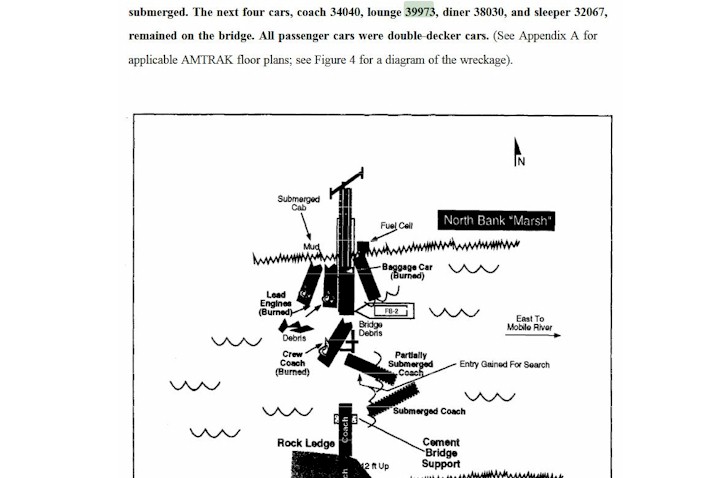
A government investigation diagram of the cars involved in the Bayou Canot accident.

